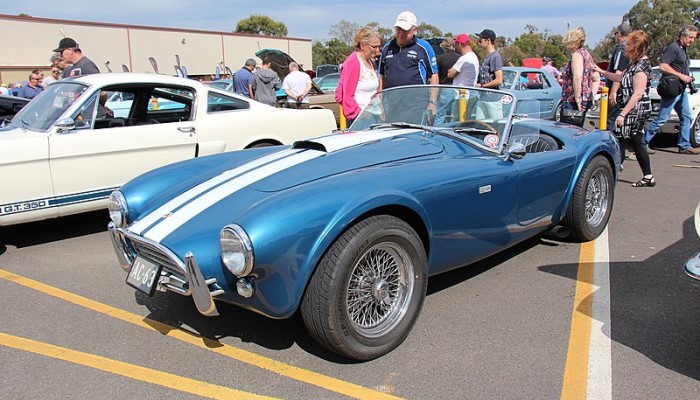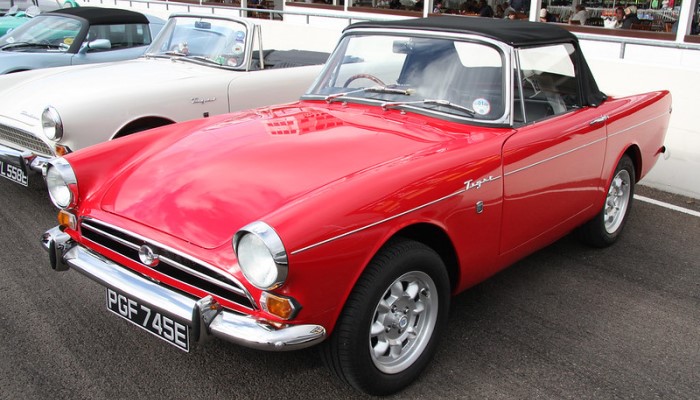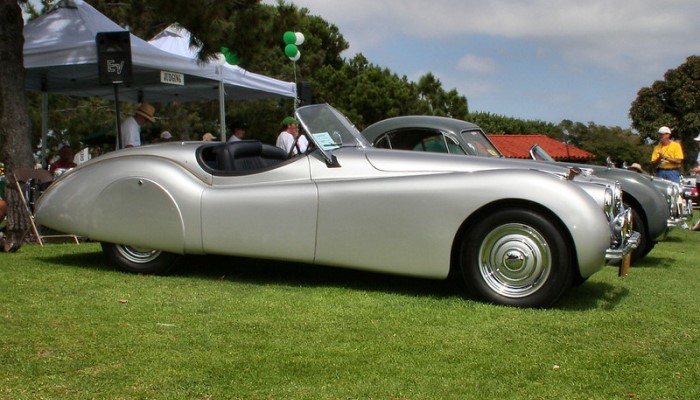1961 Jaguar E-Type
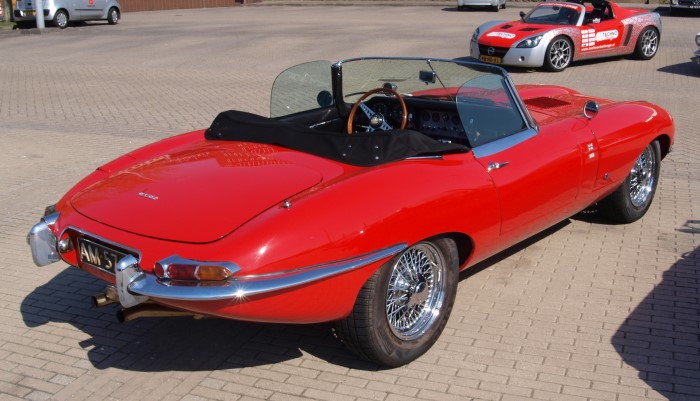
Where Luxury and Performance are in Perfect Harmony
Few cars managed to cause such a stir with their appearance as the Jaguar E at the 1961 Geneva Motor Show. This car replaced the XK series, which has been on sale since 1948.
For 13 years, despite the timely update, the Jaguar XK-120 and XK-150 had become outdated and required updating, but no one expected what the public saw on the podium of the car dealership.
Supercar with excellent performance: acceleration to 100 kph (62 mph) in 6.7 seconds and a top speed of 152 mph (245 kph).
The cabin was sporty, with leather bucket seats, a fully stocked black or aluminum instrument panel, and a wooden sports steering wheel.
And this low, sleek two-seat roadster cost just £2,098, half the price of an Aston Martin DB4.
The long hood, integral with the front fenders, when raised exposed the spatial structure of the engine compartment, which had a six-cylinder engine with a capacity of 265 hp and an independent front suspension on aluminum wishbones.
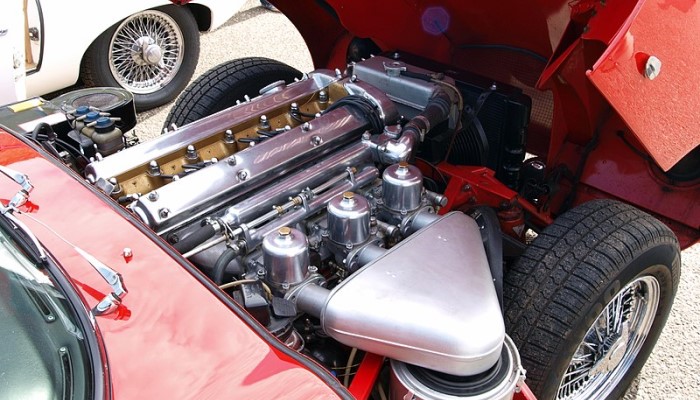
The center frame, similar in design to the Jaguar D sports model, was extremely strong. The rear independent suspension on twin coil springs and wishbones was copied from racing cars.
Its feature was, as in the main gear, brake discs. This allowed us to reduce the unsprung masses and, in turn, significantly improve the handling of the car.
However, on the first "E" series cars, this design caused the brakes to overheat in extreme conditions. Soon, this shortcoming was eliminated.
The four-speed gearbox was also not very good, also transferred from Jaguar racing cars; the first gear did not have a synchronizer.
Improvements
The deficiencies were corrected in 1964. The 3.8-liter (231 cu in) engine was replaced by a 4.2-liter (258 cu in), which provided more torque for the same power; the gearbox became fully synchronized; new headlights and a generator were installed. Minor changes have also been made to the interior.
In 1966, the Jaguar E went on sale with a new body—a three-door closed coupe with a 2-plus-2 seating formula.
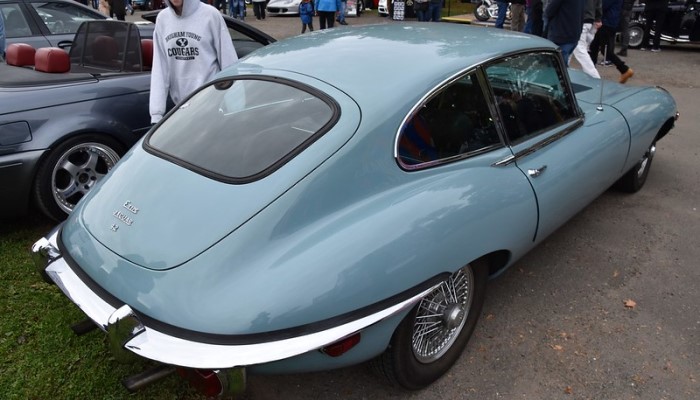
Photo: "Jaguar E-Type 4,2 Coupé (Series II, 1969)" by usf1fan2
In order for the passengers in the back row to be able to somehow sit, the wheelbase had to be increased. This also allowed a longer automatic transmission to be fitted as custom equipment.
The next changes came in 1968, when the headlights lost their fairings, the windshield became more vertical, and power steering and a safe energy-absorbing steering column were available as options.
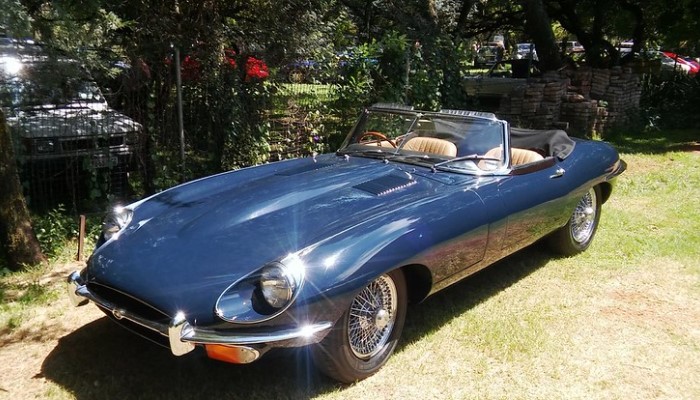
Photo: "Jaguar 1961-75 E-Type Roadster. pr.3.18" by Basic Transporter
The third series of Jaguars E was released in 1971. All cars (roadster, closed double, and 2-plus-2 coupe) were produced on an extended chassis.
There were few external changes: a chrome grille and four centrally located chrome exhaust pipes. But under the hood was now a 5.3-liter (326 cu in) V12 engine with 314 hp and a choice of automatic or manual transmission. Power steering became standard equipment.
Sir William Lyons, the company's founder, painted the last 50 Jaguar E's that rolled off the production line in February 1975 black and signed plaques for them.
Interior
As you step into the Jaguar E-Type, you are transported to a world where elegance and power seamlessly intertwine. The rich scent of leather fills the air, enveloping you in a luxurious embrace.
Every stitch on the seats and dashboard reflects the impeccable craftsmanship that this iconic British car is known for.
Looking around, you are captivated by the classic wooden steering wheel, its polished surface gleaming under the soft glow of the dashboard lights.
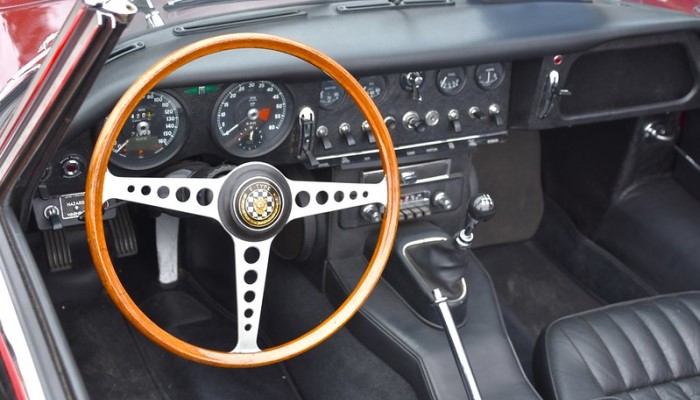
Photo: "Jaguar E-Type 4,2 Roadster (Series I, 1967)" by usf1fan2
The gauges, decorated in chrome, display a subtle elegance while accurately conveying vital information. Time seems to stand still as you soak in the vintage appeal this car exudes.
The low-slung seat creates a feeling of closeness to the road, making you feel like you're part of this marvel of automotive history.
Ergonomically designed seats cradle your body, providing maximum comfort and support even during spirited drives. It's clear that Jaguar has paid attention to every detail, ensuring the driving experience is nothing short of extraordinary.
As the center console draws your attention, you’ll be struck by the simplicity of its design. A series of elegant switches and knobs, arranged in a symphony of ergonomics, puts every control within easy reach.
With a delicate touch, you can feel the instant response this car offers, promising an exhilarating driving experience. As you run your hand along the smooth, curved lines of the interior, you realize that this is a car that was made to be driven.
Its timeless design and thoughtful construction evoke a sense of adventure, inviting you to embark on a journey that will be etched in your memory forever.
In the Jaguar E-Type, luxury meets performance in perfect harmony. Each detail, from the handcrafted leather to the intuitive controls, tells a story of a bygone era where quality and sophistication reigned supreme.
E-type in Movie Industry
The Jaguar E-Type, with its sleek and iconic design, has graced the silver screen in various films, leaving a lasting impression on car enthusiasts and moviegoers alike.
One notable appearance of the Jaguar E-Type can be seen in the classic 1969 film, "The Italian Job." In fact, the excavator/digger destroyed two E-types. Both cars were restored and still exist.
Furthermore, the fantasy adventure film, "Austin Powers: International Man of Mystery," released in 1997, also showcases the Jaguar E-Type in a comedic and exaggerated manner.
This spy spoof, directed by Jay Roach, stars Mike Myers as the flamboyant and groovy British agent, Austin Powers.
The E-Type appears as Powers' undercover car, famously colored in vibrant Union Jack design, perfectly representing the over-the-top style and humor that the film embodies.
These are just a few memorable films that have featured the Jaguar E-Type, capturing its timeless beauty and lasting appeal.
Whether in thrilling car chases, gritty crime dramas, or outrageous comedies, the E-Type continues to leave an indelible mark on the silver screen, solidifying its status as an iconic cinematic vehicle.
Jag E-type in Today's Market
Now, let me tell you, these beauties don't come cheap, but they are worth every penny for any car enthusiast out there.
The price of a Jaguar E-Type can vary depending on various factors such as its condition, mileage, and even the specific model you're looking for. But to give you a ballpark figure, you can expect to shell out anywhere from $30,000 to over $150,000 for a decent one.
Now, I must warn you, if you're looking for a pristine, fully restored model with all the bells and whistles, you may need to be prepared to loosen the purse strings a bit more. These babies can go for well over $300,000!
Of course, if you're open to a project car that needs a little TLC, you might be able to snag a bargain and bring it back to its former glory with some elbow grease and a few extra dollars.
Remember, though, you should always do your research and inspect the car thoroughly before diving in. Don't let the charming looks of the E-Type blind you to any potential issues lurking beneath that sleek exterior.
All in all, owning a Jaguar E-Type is not just about the price tag, it's about owning a piece of automotive history and enjoying the timeless beauty that these iconic cars have to offer.
So, if you've got the means and the passion, go ahead and start exploring the market. Who knows, you might just find your dream car!

Unique Car Zone Team
A group of several fans of everything that moves on four wheels, a few article creators, a couple of marketing strategists, designers, web developers, and lots of coffee.




